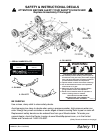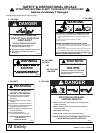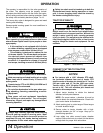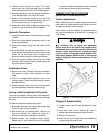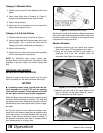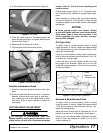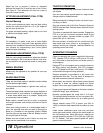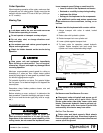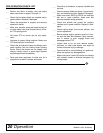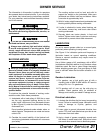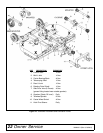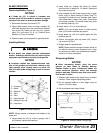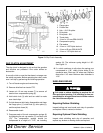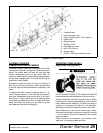
18 Operation
MAN0571 (Rev. 6/15/2007)
Adjust top link to provide 2 inches of clearance
between the break link (2) and the rear of the lift links.
See Figure 8. This clearance will allow the cutter to
float over uneven terrain.
ATTITUDE ADJUSTMENT (PULL-TYPE)
Normal Mowing
For the most economical power use and best cutting
results, the cutter should be from 1/2" to 3/4" higher at
the rear than at the front.
For grass and weed mowing, adjust cutter to run level
or with the front slightly lower.
Shredding
For shredding, it is better to set rear of cutter slightly
lower than the front. How much lower depends on the
material to be shredded. Determine the best setting for
your situation by experimenting. Use a slow ground
speed for better shredding.
DRIVELINE ADJUSTMENT (PULL-TYPE)
With the cutting height established, adjust the driveline
carrier bearings in the H-frames so that the front drive-
line is parallel to the ground with cutter in cutting posi-
tion.
WHEEL SPACING
Wheels may be adjusted to any position for row crop
shredding.
BLADE SELECTION
There are two blade options: standard suction blades
and flat double-edge blades.
The standard suction blade is a general use, multi-pur-
pose blade.
The double-edge blade requires less power because it
does not mulch or recut material. It is designed for use
in areas where blade wear is a problem. Sandy soils
are extremely hard on blades.
Blade rotation, viewed from top of cutter, is clockwise
for the right crossbar, and counter-clockwise for the left
crossbar.
When one cutting surface of a double-edge blade is
worn, the opposite one may be used by placing the
blade on a crossbar of the opposite rotation. Blades
from the right may be used on the left. Blades from the
left may be used on the right.
Blades must be moved in pairs. Never use one new
blade and one used blade on a crossbar.
TRACTOR OPERATION
Use care when operating around tree limbs and other
low objects.
Use care and reduce ground speed on rough terrain.
Always watch for hidden hazards.
Being knocked off or falling off tractor can result in seri-
ous injury or death.
Only use a tractor with a Roll Over Protective Structure
(ROPS) and seat belt. Securely fasten seat belt before
starting tractor.
The cutter is operated with tractor controls. Engage the
PTO at a low rpm to prevent excessive loads on the
cutter drive system. Increase throttle to proper PTO
speed (540 rpm or 1000 rpm).
Be sure operator is familiar with all controls and can
stop tractor and cutter quickly in an emergency. The
operator should give complete, undivided attention to
operating tractor and cutter.
OPERATING TECHNIQUE
Power for operating the cutter is supplied by the tractor
PTO. Operate PTO at 540 rpm (1000 rpm on "Q" mod-
els). Know how to stop the tractor and cutter quickly in
an emergency.
Engage PTO at a low engine rpm to minimize stress on
the drive system and gearbox. With PTO engaged,
raise PTO speed to 540 rpm (1000 rpm on "Q" models)
and maintain throughout cutting operation.
Gearbox protection is provided by a slip clutch with
replacement fiber disc. The slip clutch is designed to
slip when excessive torsional loads occur.
Move slowly into material. Adjust tractor ground speed
to provide a clean cut without lugging the tractor
engine. Use a slow ground speed for better shredding.
Proper ground speed will depend on the terrain and the
material’s height, type, and density.
Normally, ground speed will range from 2 to 5 mph.
Tall, dense material should be cut at a low speed; thin,
medium-height material can be cut at a faster ground
speed.
Always operate tractor PTO at proper rpm (540 or
1000) to maintain blade speed and to produce a clean
cut.
Under certain conditions tractor tires may roll down
some grass and prevent cutting at the same height as
the surrounding area. When this occurs, reduce your
ground speed but maintain PTO at 540 rpm (1000 rpm
on "Q" models). The lower ground speed will permit
grass to rebound partially.




